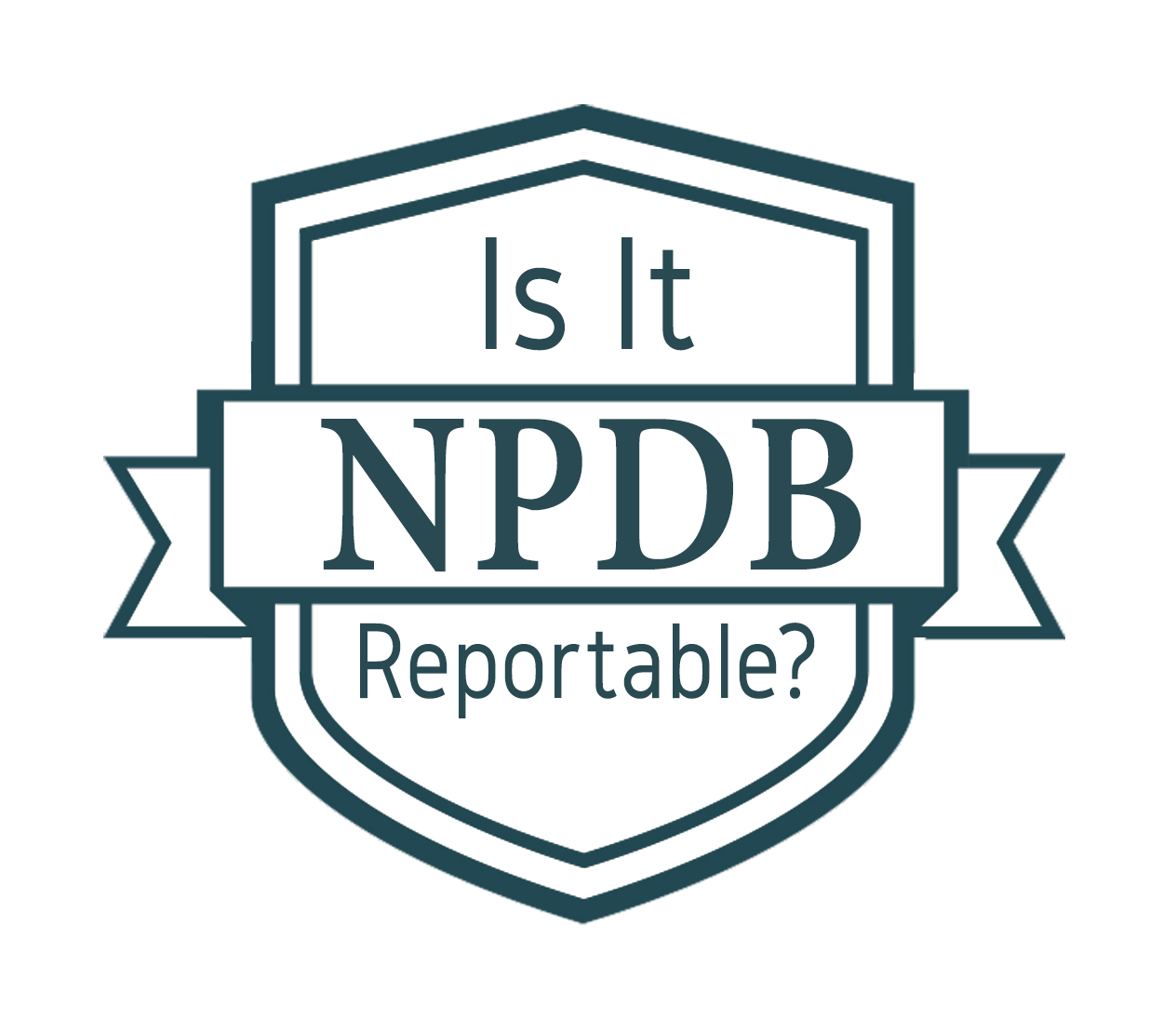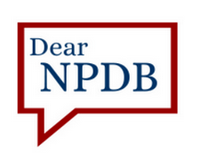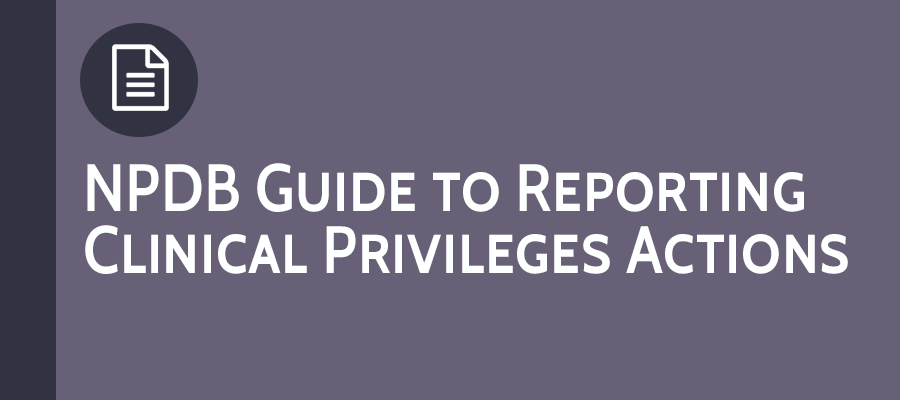NPDB Insights - February 2021

Is It Reportable?
A hospital summarily suspended a physician's clinical privileges to allow sufficient time for allegations of gross negligence to be fully investigated. The day after the summary suspension was imposed, the physician requested an educational leave of absence. If the hospital grants the leave of absence, must the summary suspension be reported to the NPDB?
If the summary suspension is not lifted within 30 days, it must be reported to the NPDB, regardless of when the leave of absence begins or if it ever occurs.
Introduction to Reporting

Reports are records of adverse actions taken by authorized organizations regarding health care practitioners, entities, providers, or suppliers. These actions include medical malpractice payments, clinical privileges actions, state licensure actions, and more. See our What You Must Report to the NPDB page for a complete list of reportable actions.
The information you provide in your report will help querying organizations make informed hiring, licensing, and credentialing decisions. You must complete the report form based on the type of action your organization took with respect to the subject of the report.
How to Submit a Report
- Sign in to the NPDB and select Report on the Select an Option page.
- On the Identify the Subject page, select whether the subject is an individual or an organization, then enter the subject's name.
- Select the Type of Action on the following page.
- Complete all four sections of the Report Form.
- Complete the Action Information section and include a detailed narrative.
- Review the information you provided to ensure it is correct, then complete the certification section.
- Save or print a copy of the report on the Report Submission Complete page for your records.
How to Retrieve a Report
After submitting a report, you may view, save, or print that report by completing the following steps:
- Sign in to the NPDB and select Reporting Activity under the Report Options section on the Select an Option page. The following Reporting Activity page lists all subjects your organization has reported on in the last 30 days, 60 days, 90 days, and All Time.
- Select the subject's name to show all reports you have submitted on that subject, with additional information on each report, such as report type, report DCN, and submitter. Select the PDF link to view the report.
Looking for information on how to submit specific report types? Check out our Step-by-Step: Reporting Clinical Privileges Actions article and stay tuned to NPDB Insights for upcoming articles on how to report state licensure actions, medical malpractice payments, health care-related criminal convictions and civil judgments, and other adjudicated actions or decisions. For additional help with reporting, visit our Reporting Help Center.
Step-by-Step: Reporting Clinical Privileges Actions
Hospitals and other health care entities must report professional review actions taken against physicians and dentists if both of the following are true:
The action taken is the result of a professional review and adversely affects clinical privileges (including privileges, medical staff or panel membership, network participation, affiliation, and other circumstances) for more than 30 days, including:
- Reduction, restriction, suspension, or revocation of privileges;
- Denial of privileges based on a professional review action (excluding denials based on the failure to meet specific threshold criteria or an initial application withdrawal before a final professional review decision);
- A practitioner's surrender of, or failure to renew, privileges while under or to avoid investigation; or
- A summary suspension that is the result of a professional review (in effect for more than 30 days), regardless of whether or not the action is final.
The action is based on the practitioner's professional competence or professional conduct that adversely affects, or could adversely affect, the health or welfare of a patient.
In addition, hospitals and other health care entities may report - and are encouraged to report - clinical privileges actions taken against practitioners other than physicians and dentists in similar circumstances.
How to Submit a Clinical Privileges Action Report
To report a clinical privileges action, you must submit an initial adverse action report within 30 days* of when the action was taken.
- Sign in to the NPDB and select Report on the Select an Option page.
- On the Identifying the Subject page, select that the subject is an individual, then enter the practitioner's name.
- On the Select Action page, select Clinical Privileges.
- Complete the Subject Information section.
- Enter the practitioner's personal information, such as names used, sex, and birth date.
- Enter the practitioner's home and work address and organization name. Note: If the practitioner's home address is unknown, enter their work address for both address sections.
- Enter all the licenses and certifications the practitioner holds (or claims to hold), including the type of license against which the action was taken.
- Enter all the schools or institutions the practitioner attended for their professional degree, training, or certification.
- Enter all the practitioner's identification numbers, such as their Social Security Number, National Provider Identifier, and Drug Enforcement Administration Number.
- Enter all the practitioner's health care entity affiliations.
- Complete the Action Information section.
- Select the adverse actions you have taken in regard to the practitioner (you can select up to five adverse actions; list the most relevant action first). Select the bases for these actions. Enter the date the action was taken, the date the action went into effect, and how long the action will remain in effect. Then include a narrative description.
Note: In the narrative description, provide background information and explain the circumstances of the action that led to the report. This description provides future queriers with a more complete understanding of what the subject did or is alleged to have done. - Review the information you provided to ensure it is correct, then complete the certification section.
Note: You must send a copy of the report to the appropriate state board, either by mailing a copy of the report to the appropriate state licensing board, or by sending a digital version through the NPDB system (provided the state board accepts digital notices). Reporting entities are responsible for ensuring that the licensing board has received the report. - Save or print a copy of the report on the Report Submission Complete page for your records.
For more comprehensive instructions and requirements for reporting clinical privileges actions, see the NPDB regulations and the NPDB Guidebook.
*As noted in the NPDB Guidebook, entities are not excused from reporting simply because they missed a reporting deadline. The Secretary of HHS will conduct an investigation if there is reason to believe an entity substantially failed to report required adverse actions. Entities have the opportunity to correct their noncompliance.
Looking for information on how to submit specific report types? Check out our Introduction to Reporting article and stay tuned to NPDB Insights for upcoming articles on how to report state licensure actions, medical malpractice payments, health care-related criminal convictions, and other adjudicated actions or decisions.

Dear NPDB
Can my organization use a practitioner's Self-Query in place of a query submitted by the organization?
A practitioner's Self-Query does not fulfill a hospital's querying requirements. As mandated by federal law, a hospital must submit their own query:
- Any time a practitioner applies for medical staff appointment (courtesy or otherwise) or for clinical privileges at the hospital (including temporary privileges)
- Every 2 years on all practitioners who are on its medical staff (courtesy or otherwise) or hold clinical privileges at the hospital
Querying the NPDB is essential for any eligible organization to make informed decisions about the practitioners, entities, providers, and suppliers with whom it is beginning a professional relationship. Without the knowledge of professional history provided by a query, an organization may have problems with patient safety, including increased medical liability risk.
When your organization queries on a practitioner, entity, provider, or supplier, you have the added security of knowing that the query response you are receiving is completely accurate and exactly as it is recorded within the NPDB. If you elect to accept a Self-Query from a practitioner, be sure to double check names, dates, and other clues of possible alterations to make sure the practitioner did not give you a fraudulent Self-Query response.
For more information about querying, including querying eligibility and instructions on how to submit a query, check out our Querying the NPDB page.
The latest updates and resources are available at https://www.npdb.hrsa.gov.
Previous editions of NPDB Insights are available in our archive.
 An official website of the United States government.
An official website of the United States government.


